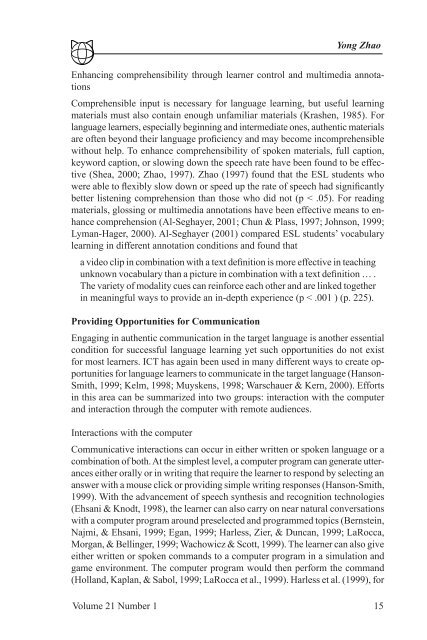Recent Developments in Technology and Language ... - CALICO
Recent Developments in Technology and Language ... - CALICO
Recent Developments in Technology and Language ... - CALICO
Create successful ePaper yourself
Turn your PDF publications into a flip-book with our unique Google optimized e-Paper software.
Yong Zhao<br />
Enhanc<strong>in</strong>g comprehensibility through learner control <strong>and</strong> multimedia annotations<br />
Comprehensible <strong>in</strong>put is necessary for language learn<strong>in</strong>g, but useful learn<strong>in</strong>g<br />
materials must also conta<strong>in</strong> enough unfamiliar materials (Krashen, 19 5). For<br />
language learners, especially beg<strong>in</strong>n<strong>in</strong>g <strong>and</strong> <strong>in</strong>termediate ones, authentic materials<br />
are often beyond their language proficiency <strong>and</strong> may become <strong>in</strong>comprehensible<br />
without help. To enhance comprehensibility of spoken materials, full caption,<br />
keyword caption, or slow<strong>in</strong>g down the speech rate have been found to be effective<br />
(Shea, 2000; Zhao, 199 ). Zhao (199 ) found that the ESL students who<br />
were able to flexibly slow down or speed up the rate of speech had significantly<br />
better listen<strong>in</strong>g comprehension than those who did not (p < .05). For read<strong>in</strong>g<br />
materials, gloss<strong>in</strong>g or multimedia annotations have been effective means to enhance<br />
comprehension (Al-Seghayer, 2001; Chun & Plass, 199 ; Johnson, 1999;<br />
Lyman-Hager, 2000). Al-Seghayer (2001) compared ESL students’ vocabulary<br />
learn<strong>in</strong>g <strong>in</strong> different annotation conditions <strong>and</strong> found that<br />
a video clip <strong>in</strong> comb<strong>in</strong>ation with a text def<strong>in</strong>ition is more effective <strong>in</strong> teach<strong>in</strong>g<br />
unknown vocabulary than a picture <strong>in</strong> comb<strong>in</strong>ation with a text def<strong>in</strong>ition … .<br />
The variety of modality cues can re<strong>in</strong>force each other <strong>and</strong> are l<strong>in</strong>ked together<br />
<strong>in</strong> mean<strong>in</strong>gful ways to provide an <strong>in</strong>-depth experience (p < .001 ) (p. 225).<br />
Provid<strong>in</strong>g Opportunities for Communication<br />
Engag<strong>in</strong>g <strong>in</strong> authentic communication <strong>in</strong> the target language is another essential<br />
condition for successful language learn<strong>in</strong>g yet such opportunities do not exist<br />
for most learners. ICT has aga<strong>in</strong> been used <strong>in</strong> many different ways to create opportunities<br />
for language learners to communicate <strong>in</strong> the target language (Hanson-<br />
Smith, 1999; Kelm, 199 ; Muyskens, 199 ; Warschauer & Kern, 2000). Efforts<br />
<strong>in</strong> this area can be summarized <strong>in</strong>to two groups: <strong>in</strong>teraction with the computer<br />
<strong>and</strong> <strong>in</strong>teraction through the computer with remote audiences.<br />
Interactions with the computer<br />
Communicative <strong>in</strong>teractions can occur <strong>in</strong> either written or spoken language or a<br />
comb<strong>in</strong>ation of both. At the simplest level, a computer program can generate utterances<br />
either orally or <strong>in</strong> writ<strong>in</strong>g that require the learner to respond by select<strong>in</strong>g an<br />
answer with a mouse click or provid<strong>in</strong>g simple writ<strong>in</strong>g responses (Hanson-Smith,<br />
1999). With the advancement of speech synthesis <strong>and</strong> recognition technologies<br />
(Ehsani & Knodt, 199 ), the learner can also carry on near natural conversations<br />
with a computer program around preselected <strong>and</strong> programmed topics (Bernste<strong>in</strong>,<br />
Najmi, & Ehsani, 1999; Egan, 1999; Harless, Zier, & Duncan, 1999; LaRocca,<br />
Morgan, & Bell<strong>in</strong>ger, 1999; Wachowicz & Scott, 1999). The learner can also give<br />
either written or spoken comm<strong>and</strong>s to a computer program <strong>in</strong> a simulation <strong>and</strong><br />
game environment. The computer program would then perform the comm<strong>and</strong><br />
(Holl<strong>and</strong>, Kaplan, & Sabol, 1999; LaRocca et al., 1999). Harless et al. (1999), for<br />
Volume 21 Number 1 15
















